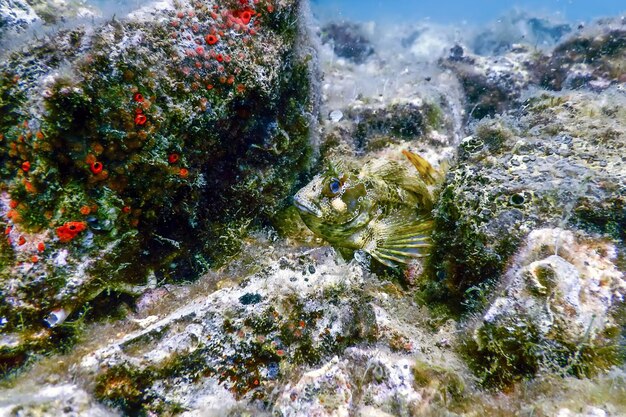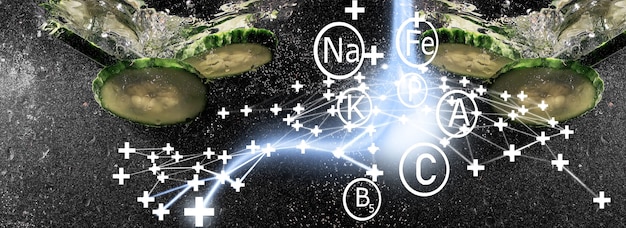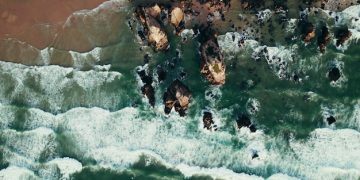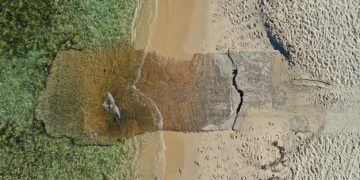How Climate Change Drives Ocean Acidification & US Fisheries Impact

Ocean acidification, primarily driven by increased carbon dioxide absorption from climate change, significantly reduces ocean pH, posing profound threats to US fisheries by impacting marine life calcification, behavior, and habitat viability, thus jeopardizing commercial and recreational fishing industries.
The intricate dance between Earth’s climate and its vast oceans is facing an unprecedented challenge, one that threatens the very foundation of marine ecosystems. Understanding how climate change affects ocean acidification, and what are the consequences for US fisheries, is crucial for safeguarding both our natural heritage and a vital economic sector.
The undeniable link: climate change and ocean chemistry
The Earth’s oceans are vast carbon sinks, absorbing a significant portion of the carbon dioxide (CO2) released into the atmosphere by human activities. While this service helps mitigate global warming, it comes at a steep price: a fundamental change in ocean chemistry known as ocean acidification.
As CO2 dissolves into seawater, it forms carbonic acid, which then releases hydrogen ions. These ions increase the water’s acidity, lowering its pH. Over the past 200 years, the average pH of the ocean has dropped by about 0.1 units, representing a 30% increase in acidity. While a 0.1 pH change might seem small, it’s a monumental shift on a planetary scale, occurring at a rate unprecedented in the last 50 million years.
The basic chemistry explained
The process begins with atmospheric CO2, largely from the burning of fossil fuels, dissolving into ocean surface waters. This dissolved CO2 reacts with water to form carbonic acid (H2CO3).
- Carbonic acid quickly dissociates into bicarbonate (HCO3-) and a hydrogen ion (H+).
- The increase in hydrogen ions leads to a decrease in ocean pH, making the water more acidic.
- Crucially, these excess hydrogen ions also react with carbonate ions (CO32-), which are essential for many marine organisms to build their shells and skeletons.
This reduction in available carbonate ions is particularly alarming for calcifying organisms. When carbonate ions are less available, these organisms must expend more energy to build and maintain their calcium carbonate structures, leaving less energy for growth, reproduction, and other life processes.
The long-term implications of this chemical shift are far-reaching, affecting everything from microscopic plankton to vast marine ecosystems, with cascading effects on the industries that depend on them.
Direct impacts on marine life: a struggle for survival
The immediate and measurable effects of ocean acidification are felt by marine organisms, particularly those at the base of the food web. These impacts threaten not only individual species but entire ecosystems, disrupting delicate balances built over millennia.
Calcifying organisms – those that build shells or skeletons out of calcium carbonate – are among the most vulnerable. This group includes a wide array of species, from tiny pteropods and foraminifera to economically significant shellfish like oysters, clams, and scallops, as well as crucial ecosystem engineers like corals.
Shellfish and crustaceans caught in the acid shift
For shellfish, the increased acidity makes it harder to form and maintain their shells. Larval stages are particularly susceptible, as they typically have thinner shells or are in the process of rapidly growing their first structures. Studies have shown that oyster larvae, for instance, experience significant mortality and developmental abnormalities in more acidic waters.
- Difficulty forming robust shells and skeletons.
- Increased energy expenditure on calcification, diverting resources from growth and reproduction.
- Reduced survival rates, especially during vulnerable larval stages.
- Potential for dissolution of existing shells in highly acidic conditions.
Crustaceans, such as crabs and lobsters, also rely on calcium carbonate for their exoskeletons. While they may be more resilient than some mollusks, prolonged exposure to acidic conditions can weaken their shells, making them more vulnerable to predators and diseases, and potentially hindering their molting processes. These effects begin a domino effect throughout the marine food web, affecting species far beyond those directly impacted.

Cascading effects through marine food webs
The impacts of ocean acidification do not stop at calcifying organisms. They ripple through entire marine food webs, affecting species far removed from the direct chemical changes. Fishery species, whether they are calcifiers themselves or rely on them for food, face complex challenges that can ultimately reduce their populations and productivity.
Small calcifiers like pteropods, often called “sea butterflies,” are a critical food source for numerous fish species, including salmon, cod, and mackerel. If pteropod populations decline due to acidification, these commercially important fish may suffer from a lack of food, leading to reduced growth rates, lower reproductive success, and ultimately, smaller stocks.
Impacts on commercially important fish species
While finfish generally do not calcify in the same way as shellfish, they are not immune. Acidification can affect their physiology, behavior, and foraging abilities. Studies have shown that increased CO2 levels can impair the ability of some fish to detect predators or find suitable habitats, leading to altered schooling behaviors and reduced survival.
- Disruption of sensory systems (e.g., sense of smell, hearing).
- Changes in foraging behavior and predator avoidance.
- Altered metabolic rates and growth.
- Impacts on reproductive success and early life stages.
Furthermore, the degradation of habitat-forming species like corals and shellfish beds, which provide shelter and nurseries for many fish species, also has significant indirect effects. For example, declining healthy oyster reefs deprive juvenile fish of crucial refuge, making them more vulnerable to predation and environmental stressors.
The health of these interdependent ecosystems is paramount for maintaining robust fish populations. A reduction in the abundance or health of one species can trigger a trophic cascade, impacting the entire web.
US fisheries at risk: economic and social implications
The United States boasts a diverse and economically vital fishing industry, spanning from the abundant oyster beds of the Pacific Northwest and the Gulf of Mexico to the lucrative salmon fisheries of Alaska and the lobster traps of New England. Ocean acidification presents a multifaceted threat to these regions, jeopardizing livelihoods, cultural practices, and food security.
The West Coast, in particular, has already experienced firsthand the economic fallout of ocean acidification. Oyster hatcheries in the Pacific Northwest faced significant setbacks when their larvae failed to develop in increasingly acidic waters. This led to substantial economic losses and a urgent need for adaptation strategies, including monitoring ocean conditions and adjusting water intake.
Regional vulnerabilities across the US
Different US regions face unique vulnerabilities depending on their prevalent species and local oceanographic conditions. Alaska’s crab and salmon fisheries, for example, are highly susceptible due to the naturally colder waters of the Arctic and Subarctic, which can absorb more CO2 and thus acidify faster.
Similarly, the Gulf of Mexico and the East Coast’s vast shellfish industries, including clams, oysters, and scallops, face escalating risks. These industries often support local economies and provide traditional ways of life for coastal communities.
- Pacific Northwest: Oyster and clam aquaculture highly vulnerable, with documented losses.
- Alaska: Cold-water species like crabs, pollock, and salmon are at risk due to high CO2 absorption.
- Northeast: Lobster and scallop industries could face long-term impacts, particularly on larval stages.
- Southeast and Gulf of Mexico: Oyster reefs and other shellfish are critical, providing both economic value and ecosystem services.
The potential economic consequences are staggering. Job losses in fishing, processing, and related tourism industries could be widespread. Diminished catches would also impact seafood availability and prices for consumers, creating a ripple effect across the national food supply chain. The social fabric of many coastal communities, deeply intertwined with the fishing industry, faces significant disruption.

Adaptation and mitigation strategies for fisheries
Addressing the challenge of ocean acidification requires a dual approach: mitigating global CO2 emissions to slow the rate of change and developing adaptation strategies to help fisheries cope with the changes already underway. While global action on climate change is paramount, local and regional efforts are also critical for immediate impact.
For the fisheries sector, adaptation measures largely focus on reducing stress on vulnerable species and enhancing their resilience. This can include developing more resilient strains of shellfish through selective breeding, moving aquaculture operations to areas with more stable pH conditions, or even employing technologies to modify water chemistry in controlled environments like hatcheries.
Innovative solutions and policy responses
Technological innovation plays a key role. For example, some oyster hatcheries have implemented systems to monitor and adjust the pH of incoming seawater, providing a buffer for sensitive larval stages. Research into genetic selection for more resilient species, as well as understanding the combined effects of acidification with other stressors like warming temperatures and hypoxia, is ongoing.
- Developing ocean observation networks for real-time pH monitoring.
- Implementing adaptive management strategies for fisheries based on acidification forecasts.
- Investing in research on resilient species and aquaculture techniques.
- Protecting and restoring coastal habitats that can help buffer local acidification, such as seagrass beds.
Policy responses are also vital. This includes funding scientific research, supporting the development and implementation of adaptation technologies, and establishing clear regulatory frameworks to help guide the industry. On a broader scale, policies aimed at reducing greenhouse gas emissions globally are the ultimate solution to the root cause of ocean acidification.
Collaboration among scientists, policymakers, and industry stakeholders is essential to identify effective solutions and ensure a sustainable future for US fisheries.
The long-term outlook and call to action
The trajectory of ocean acidification is directly linked to global carbon emissions. Without significant reductions in CO2, the oceans will continue to acidify at an alarming rate, exacerbating the challenges faced by marine ecosystems and the economies that rely on them. The long-term outlook necessitates a fundamental shift in how human societies generate and consume energy.
However, the future is not pre-determined. Every action to reduce greenhouse gas emissions, no matter how small, contributes to mitigating the severity of ocean acidification. From transitioning to renewable energy sources to improving energy efficiency and promoting sustainable land use practices, a concerted global effort is required.
Global efforts and local responsibilities
International agreements and national policies aimed at climate action are crucial. The Paris Agreement, for instance, sets ambitious goals for reducing emissions. Within the United States, federal and state-level initiatives can support carbon reduction efforts and fund research and adaptation strategies for coastal communities and fisheries.
Beyond large-scale policy, individual and community-level actions also contribute. Supporting sustainable seafood, reducing personal carbon footprints, advocating for climate action, and participating in local conservation efforts can collectively make a difference.
The health of US fisheries is deeply intertwined with the health of the global ocean, which in turn is intrinsically linked to global climate patterns. Understanding the science, acknowledging the risks, and acting decisively are critical steps toward protecting these invaluable resources for generations to come. The silent threat of ocean acidification demands our urgent attention and collective responsibility.
| Key Aspect | Brief Description |
|---|---|
| 🌊 Ocean Chemistry Shift | Increased atmospheric CO2 leads to higher oceanic CO2 absorption, lowering ocean pH and increasing acidity. |
| 🐚 Marine Life Impact | Calcifying organisms (e.g., shellfish, corals, pteropods) struggle to form and maintain shells/skeletons. |
| 🎣 Fishery Consequences | Reduced populations of commercial species, economic losses for US fisheries, and threats to coastal communities. |
| 🌱 Mitigation & Adaptation | Requires global CO2 emission reductions and local strategies like selective breeding and pH water monitoring. |
Frequently Asked Questions about Ocean Acidification and US Fisheries
▼
Ocean acidification refers to the ongoing decrease in the pH of the Earth’s oceans, caused by the absorption of excess carbon dioxide (CO2) from the atmosphere. This CO2 primarily comes from human activities, such as the burning of fossil fuels, which also drives climate change. As the ocean absorbs more CO2, it forms carbonic acid, making the water more acidic.
▼
Species that build shells or skeletons from calcium carbonate are especially vulnerable. This includes shellfish like oysters, clams, and scallops, as well as crabs, corals, and tiny plankton called pteropods. While finfish are not direct calcifiers, they can be indirectly affected by impacts on their food sources and habitat, and some studies suggest direct physiological effects as well.
▼
The economic impacts can be severe. Reduced populations of commercially important shellfish can lead to significant drops in harvest, revenue losses for fishing businesses, and job losses in coastal communities. Hatcheries face increased costs for water treatment and higher mortality rates of larvae. This also affects the seafood supply chain and consumer prices.
▼
Efforts range from global CO2 emission reductions to local adaptation strategies. Research is ongoing to develop more resilient aquaculture species through selective breeding and to understand combined stressors. Some hatcheries use pH-buffered water. Policy initiatives support monitoring, research, and collaborative action among scientists, industry, and government to develop effective responses.
▼
While the primary driver is global CO2 emissions, individual actions collectively contribute to mitigation. Reducing your carbon footprint (e.g., through energy conservation, choosing sustainable transportation), supporting renewable energy, advocating for climate-friendly policies, and supporting sustainable seafood choices can all help reduce the overall CO2 burden on the oceans.
A crucial moment for ocean stewardship
The interconnectedness of climate change, ocean acidification, and the vitality of US fisheries underscores a profound environmental and economic challenge. As the oceans continue to absorb increasing amounts of CO2, the silent transformation of their chemistry poses an existential threat to marine life and the livelihoods dependent on it. The long-term health of our fisheries, therefore, hinges not only on our understanding of these complex processes but, more critically, on our collective will to enact meaningful, sustained change.





